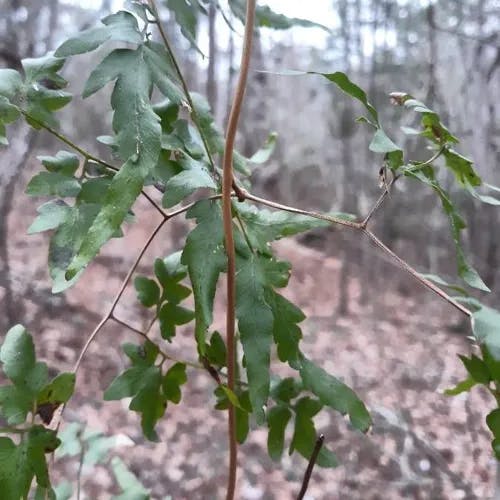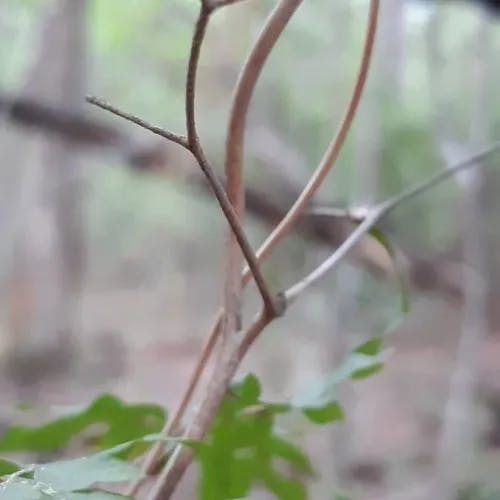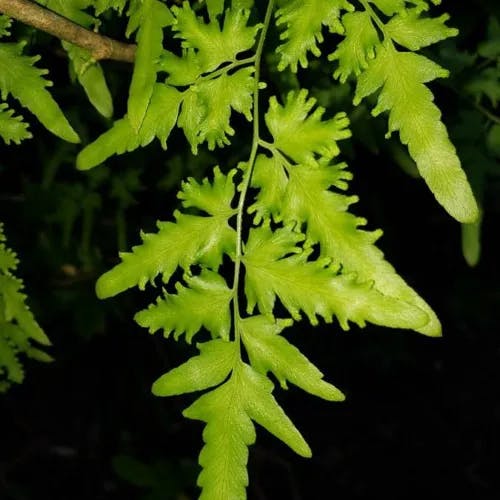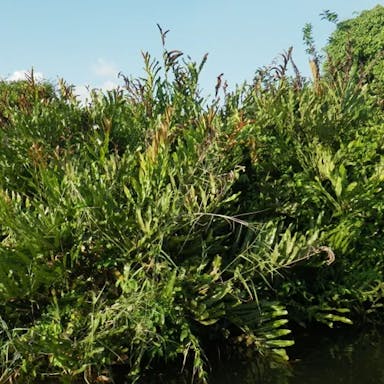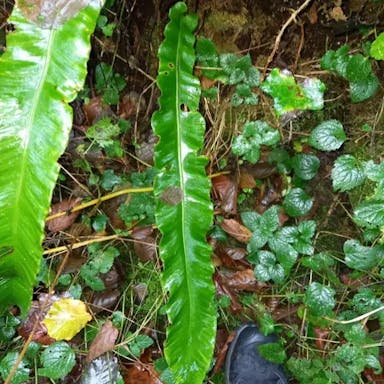Japanese climbing fern thrives in partial to full shade, making it suitable for areas with limited direct sunlight. It exhibits moderate cold tolerance, surviving in USDA hardiness zones 6 to 9. This fern prefers temperatures between 60-75°F (15-24°C) and can withstand occasional drops below freezing. It is sensitive to extreme heat and may require protection during hot summer months. Overwintering indoors or in a sheltered location can help prevent frost damage. Japanese climbing fern should be placed in a location with filtered sunlight to prevent leaf scorch. It can tolerate low light conditions but thrives with at least 4-6 hours of indirect sunlight per day.
Japanese climbing fern
- Scientific name
- Lygodium japonicum
Basic Information
- Schizaeaceae Family Lygodium Genus Japanese climbing fern Species
- Schizaeaceae > Lygodium > Lygodium japonicum
- 83%
- The Completeness of This Encyclopedia
Please help us complete the encyclopedia, Terrarium is a encyclopedia service to be completed with everyone in the world. Currently, this page is 83% complete. For more information on how to contribute, please click here.
- Pteridophyta
- Vine
- Height
- 300cm ~
- Flower Color
- Leaf Color
- Anthesis
- summer
- Sunlight Exposure
Full Sun Long hours of sunlight from morning to afternoon Partial Shade A location in the shade of a tree or where either the morning or afternoon is shaded Full Shade A place where there is no direct sunlight
- Partial Shade
- Hardiness Zones
This is an indicator to know to which zone each plant can winter. Knowing the zone of each plant gives you an idea of the cold temperature resistance when grown in the ground without a roof. 2: -42.7 to -40.0 3: -39.9 to -34.4 4: -34.3 to -28.9 5: -28.8 to -23.3 6: -23.2 to -17.8 7: -17.7 to -12.2 8: -12.1 to -6.7 9: -6.6 to -1.1 10: -1.0 to 4.4 11: 4.5 to 10.0
- 7
- Cold resistance
- Fair
- Heat resistance
- Good
- Habitat of origin
- Japan, China, Korea
- Growth Rate
- Fast
What is Japanese climbing fern (Lygodium japonicum)?"Japanese climbing fern" is also called {{common_names}} and scientific name is called "Lygodium japonicum".
"Japanese climbing fern" is also called {{common_names}} and scientific name is called "Lygodium japonicum".
What is Japanese climbing fern (Lygodium japonicum)
Flower meaning
Japanese climbing fern thrives in well-drained, acidic soils with a pH range of 4.5 to 6.0. It requires a rich soil quality with high organic matter content. Fertilize the plant with a balanced slow-release fertilizer in early spring and mid-summer. Apply the fertilizer at a rate of 1 pound per 100 square feet of planting area. Avoid over-fertilization, as it can lead to excessive growth and potential invasiveness. Monitor the plant's growth and adjust the fertilizer application accordingly. Regularly check the soil pH to ensure it remains within the optimal range for Japanese climbing fern.
Calendar of Japanese climbing fern (Lygodium japonicum)"Japanese climbing fern" is also called {{common_names}} and scientific name is called "Lygodium japonicum".
"Japanese climbing fern" is also called {{common_names}} and scientific name is called "Lygodium japonicum".
Calendar
The flower language commonly used in America for the Japanese climbing fern is: - Sincerity - Devotion - Perseverance One typical example is "Sincerity," symbolizing genuine feelings and honesty in relationships. This reflects the plant's graceful appearance and its ability to climb and thrive in various conditions. Birth flowers are specified by month and date only.
How to grow Japanese climbing fern (Lygodium japonicum)"Japanese climbing fern" is also called {{common_names}} and scientific name is called "Lygodium japonicum".
"Japanese climbing fern" is also called {{common_names}} and scientific name is called "Lygodium japonicum".
Watering
Japanese climbing fern requires regular pruning to prevent overgrowth and maintain its health. Pruning is necessary to remove dead or damaged fronds, promote new growth, and prevent the plant from spreading uncontrollably. The best time to prune Japanese climbing fern is in late winter or early spring before new growth emerges. When pruning, use sharp, clean tools to make precise cuts at the base of the fronds. Remove any yellow or brown fronds, as well as any tangled or overcrowded growth. After pruning, dispose of the cuttings properly to prevent the spread of spores and potential infestation. Regular pruning will help Japanese climbing fern thrive and remain an attractive addition to your garden.
Soil and Fertilizer
Japanese climbing fern can be propagated through spores, which are produced on the underside of the fronds. To propagate using spores, collect mature fronds with spores and place them in a paper bag to dry. Once dry, shake the fronds to release the spores onto a tray of moist soil. Keep the soil moist and warm to encourage spore germination. Alternatively, Japanese climbing fern can also be propagated through division. To propagate through division, carefully separate the rhizomes and plant them in individual pots with well-draining soil. Keep the soil consistently moist until new growth appears. Division is best done in the spring when the plant is actively growing.
Sunlight and Place
Japanese climbing fern thrives best when potted rather than planted in-ground. To pot this fern, choose a container with drainage holes to prevent waterlogging. Fill the pot with a well-draining potting mix, placing the fern in the center at the same depth as its previous container. Water the plant thoroughly after potting, allowing excess water to drain. Place the potted fern in a location with indirect sunlight and high humidity. Repot the fern every 2-3 years to refresh the soil and provide more space for growth. If the fern becomes root-bound, gently loosen the roots before repotting. Monitor for pests like spider mites and scale insects, treating promptly if detected.
Advanced Information of Japanese climbing fern (Lygodium japonicum)"Japanese climbing fern" is also called {{common_names}} and scientific name is called "Lygodium japonicum".
"Japanese climbing fern" is also called {{common_names}} and scientific name is called "Lygodium japonicum".
Pruning
Japanese climbing fern is susceptible to various pests and diseases, including scale insects, aphids, and leaf spot diseases. These pests and diseases can weaken the plant, leading to stunted growth and leaf discoloration. Scale insects are small, immobile pests that feed on plant sap, causing yellowing and wilting of leaves. Aphids, on the other hand, suck sap from the plant, causing distorted growth and yellowing of leaves. Leaf spot diseases are fungal infections that result in dark spots on the leaves, eventually leading to leaf drop. To prevent these issues, regular inspection of the plant for signs of pests and diseases is crucial. Additionally, maintaining proper air circulation around the plant and avoiding overwatering can help prevent fungal infections. Proper pruning and removing affected plant parts can also aid in controlling pests and diseases.
Planting and Harvest
Japanese climbing fern typically blooms in late spring to early summer in the United States. The flowers are at their best during the month of June. Blooming occurs once a year, lasting for about 2-3 weeks. To extend the blooming period, ensure the plant receives adequate sunlight, water, and nutrients. Pruning dead fronds can also promote continuous blooming. Maintaining a consistent watering schedule and providing well-draining soil can help prolong the flowering time. Additionally, avoiding over-fertilization and protecting the plant from extreme temperatures can contribute to a longer blooming season.
Propagation
Japanese climbing fern has two common varieties: one with green fronds and another with variegated fronds. When selecting seedlings, choose those with well-established roots and no signs of wilting or discoloration. Ensure the leaves are vibrant and free from pests or diseases. For seeds, opt for fresh ones that are plump and firm to the touch. Avoid seeds that are discolored or damaged. When purchasing, inquire about the age of the seeds to ensure viability. Select varieties based on your preference for foliage color and growth habits. Research the specific requirements of each variety to ensure successful cultivation.
Pests and Diseases
Japanese climbing fern, scientifically known as Lygodium japonicum, is a perennial vine native to East Asia. It is characterized by its delicate, feathery fronds that can climb and cover large areas rapidly. The plant produces spores rather than flowers, with a green coloration that darkens as it matures. Lygodium japonicum is classified as a fern, specifically a climbing fern, due to its ability to twine around other vegetation for support. It is considered an invasive species in many regions due to its aggressive growth habits. The plant does not produce fruits but reproduces through spores released from its fronds. It can reach sizes of up to 90 feet in length under optimal conditions. Despite its ornamental appeal, it requires careful management to prevent it from spreading uncontrollably.
Habitat of Japanese climbing fern (Lygodium japonicum)"Japanese climbing fern" is also called {{common_names}} and scientific name is called "Lygodium japonicum".
"Japanese climbing fern" is also called {{common_names}} and scientific name is called "Lygodium japonicum".
Habitat
Toxicity of Japanese climbing fern (Lygodium japonicum)"Japanese climbing fern" is also called {{common_names}} and scientific name is called "Lygodium japonicum".
"Japanese climbing fern" is also called {{common_names}} and scientific name is called "Lygodium japonicum".
Health Benefits
- edible
- Inedible
- Toxic
- No toxicity
NO DATA
Toxic for dogs and cats
NO DATA

